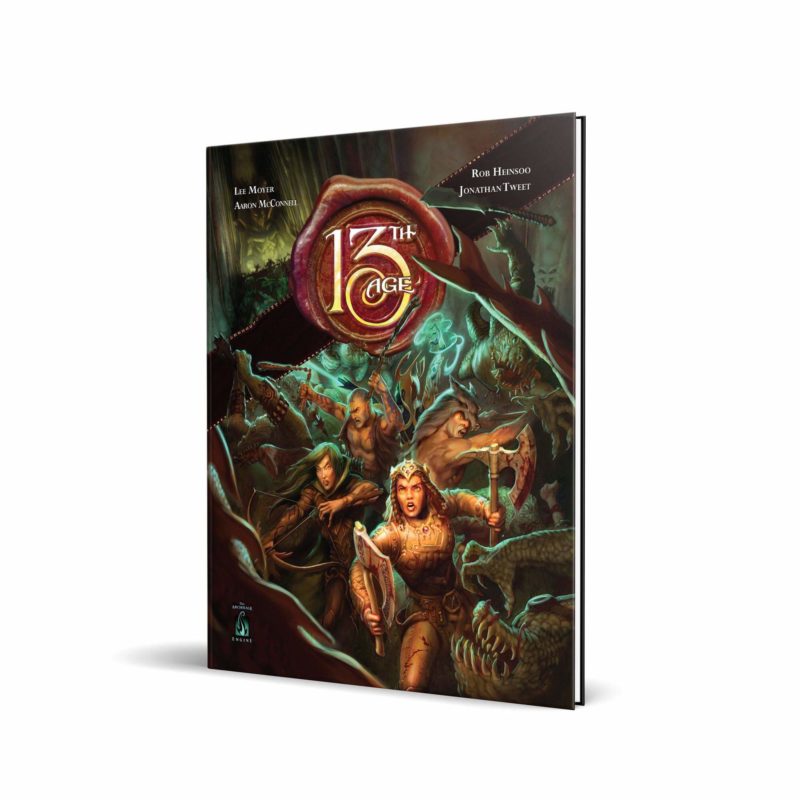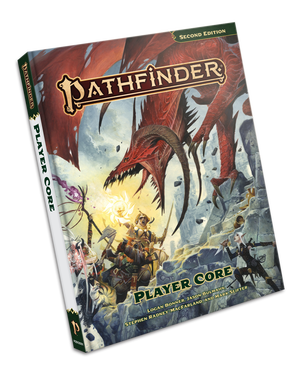13th Age Fantasy; High-Fantasy; Class-based; Collaborative Worldbuilding; Narrative-Driven; Tactical Combat; Cinematic
13th Age is a fantasy tabletop roleplaying game that blends d20 mechanics with narrative-focused gameplay. It emphasizes collaborative worldbuilding, character-driven stories, and tactical combat. The game distinguishes itself through its Icons, abstract range bands, and the Escalation Die, which promotes dynamic and cinematic encounters. 13th Age aims to provide a streamlined and flavorful experience for players seeking heroic fantasy adventures.
Theme and Setting
13th Age is set in a high-fantasy world defined by the influence of thirteen powerful Icons. These Icons are not deities but rather individuals or factions wielding significant control over various aspects of the world, such as the Archmage, the Emperor, the Crusader, the Lich King, and the Great Gold Wyrm. The world's details are intentionally left somewhat vague, encouraging GMs and players to collaboratively shape the setting to fit their campaign's needs. This approach allows for a customized and emergent world, where player choices and Icon relationships directly impact the unfolding narrative.
The Icons themselves serve as both literal characters and symbolic representations of their respective factions and ideals. Players establish relationships with these Icons during character creation, indicating whether their character has a positive, negative, or troubled connection. These relationships provide immediate plot hooks and guide the GM in tailoring the campaign to the players' interests. For example, a character with a positive relationship with the High Druid and a hostile relationship with the Lich King signals an interest in stories involving the defense of nature against undead threats. This collaborative approach ensures the game's world feels both epic and deeply personal.
Core Mechanics and Rules
13th Age utilizes a d20-based system, familiar to players of Dungeons & Dragons and similar games. However, it introduces several key mechanics that differentiate it from traditional d20 systems. Character creation involves choosing a race, class, and backgrounds, but also includes defining a 'One Unique Thing,' a singular aspect that sets the character apart in the world. This element encourages creativity and helps to establish a character's identity from the outset.
Instead of a detailed skill list, 13th Age uses backgrounds, which are broader descriptions of a character's past experiences and professions (e.g., 'minstrel,' 'gladiator,' 'cat burglar'). Backgrounds provide bonuses to relevant skill checks, emphasizing narrative justification over strict mechanical definitions. This approach promotes flexibility and encourages players to think creatively about how their character's history informs their actions.
Combat in 13th Age is designed to be fast-paced and cinematic. The game replaces grid-based movement with abstract range bands: engaged, nearby, and far away. This simplifies positioning and allows for more fluid and dynamic encounters. A key mechanic is the Escalation Die, a d6 that increases by one each round of combat, granting an increasing bonus to player attack rolls. This encourages aggressive play and prevents combats from becoming protracted or predictable. Martial classes are also enhanced via 'flexible melee attacks', allowing them to use different maneuvers depending on their attack roll results, adding tactical depth. Healing is streamlined through a recovery system, where characters can spend limited recoveries to regain hit points, further emphasizing the heroic, action-oriented nature of the game.
Unique Features
Several elements distinguish 13th Age from other d20-based RPGs:
- Icons: As described previously, the Icon relationship system provides a framework for integrating player characters into the broader world narrative and generating plot hooks. The level of investment players choose to put into each Icon essentially surveys what aspects of the world they are interested in.
- One Unique Thing: Encourages player creativity and helps define characters beyond their mechanical stats. The GM ultimately decides when the 'One Unique Thing' will activate, allowing control over how much it impacts the narrative.
- Abstract Range Bands: Simplifies combat positioning and promotes dynamic encounters. This abstract system removes the need for precise measurements and focuses on the overall flow of the battle.
- Escalation Die: Accelerates combat, increases tension, and rewards aggressive play. It also has the added benefit of negating the effectiveness of 'novaing', which is casting damaging AOE spells in the first round of combat.
- Backgrounds: Offer a flexible and narrative-driven alternative to traditional skill lists. It keeps PC backstories in the forefront, and encourages new material for the GM. It also allows players to surprise the GM with uses for their backgrounds that were never discussed before.
13th Age also streamlines certain aspects of character customization. Feats are more focused and less numerous compared to some other d20 systems, and the game deemphasizes the importance of mundane equipment, focusing instead on magic items and character abilities.
Target Audience and Player Experience
13th Age is aimed at players who enjoy heroic fantasy, collaborative storytelling, and tactical combat, but who prefer a streamlined and less rules-heavy experience than some traditional d20 games. It is well-suited for groups who appreciate character-driven narratives and are comfortable with improvisational play.
The game encourages players to actively participate in shaping the world and influencing the story, creating a sense of ownership and investment in the campaign. The combat system is designed to be exciting and dynamic, with the Escalation Die and flexible melee attacks adding a layer of tactical depth. While some players may find the abstract range bands and simplified skill system less precise than traditional grid-based combat and detailed skill lists, others will appreciate the increased speed and narrative focus.
Some find that the Icons are difficult to grasp while others have said that the choices for talents and feats are too obvious. However, the overall experience is one of a fast-paced, cinematic, and collaborative adventure, where players and GMs work together to create memorable stories in a world shaped by their choices.



